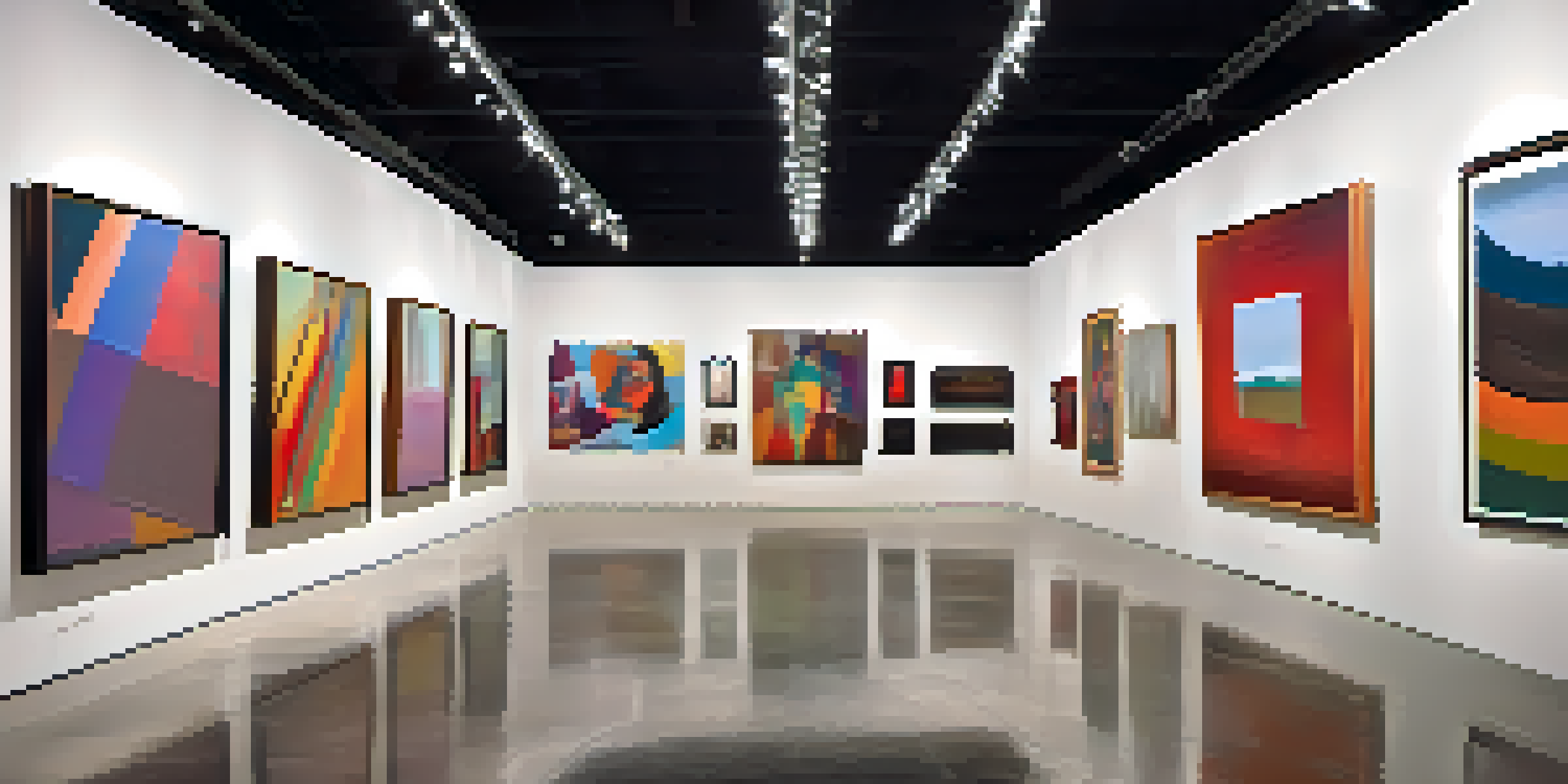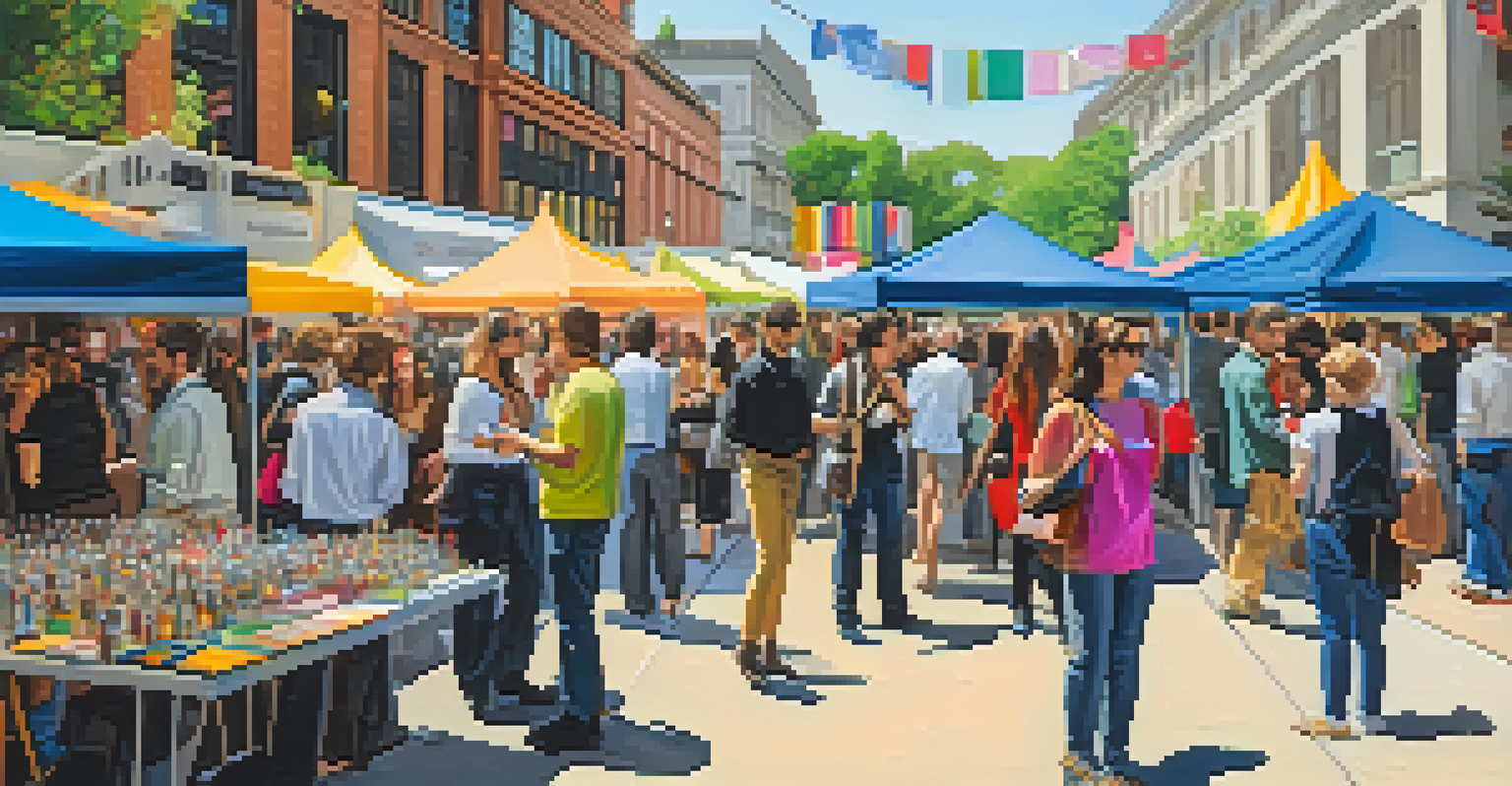How Art Institutions Shape Contemporary Painting Trends Today

The Role of Art Institutions in Shaping Trends
Art institutions, including museums and galleries, play a pivotal role in influencing contemporary painting trends. They curate exhibitions that spotlight emerging artists and innovative styles, effectively guiding public interest. This curated exposure can lead to broader acceptance and popularity of certain artistic movements, shaping the direction of contemporary art.
Art is not freedom from discipline, but disciplined freedom.
For example, an exhibition featuring abstract expressionism can reignite interest in this style, prompting artists to experiment within that genre. Institutions serve as a cultural touchstone, often dictating what is seen as 'valuable' or 'relevant' in the art world. The ripple effect of these trends can be seen in the works produced by artists who are influenced by these exhibitions.
Furthermore, art institutions often provide resources and support for artists, helping them to develop their work and gain visibility. This symbiotic relationship fosters a thriving creative community, where trends not only emerge but are nurtured and evolved.
Exhibitions: A Platform for Emerging Artists
Exhibitions at art institutions serve as essential platforms for emerging artists to showcase their work. These events often attract art critics, collectors, and the general public, providing invaluable exposure to new talent. When an institution highlights an artist, it can lead to further opportunities, such as gallery representation or inclusion in prestigious art fairs.

For instance, a small gallery may host a solo exhibition for an unknown artist, which could propel them into the spotlight if the show garners positive attention. This not only benefits the artist but also enriches the art community by diversifying the voices represented in contemporary painting. As a result, art institutions become critical players in the careers of emerging talents.
Art Institutions Shape Trends
Art institutions curate exhibitions that highlight emerging artists and styles, influencing contemporary painting trends.
By recognizing and promoting fresh perspectives, these institutions contribute to the evolution of painting trends. The continuous influx of new ideas keeps the artistic dialogue vibrant and dynamic, ensuring that contemporary painting remains relevant and engaging.
Curatorial Choices: The Power of Selection
Curators at art institutions wield significant power through their selection of featured artists and artworks. Their choices can define the narratives and themes that resonate within contemporary painting. This selective process can either reinforce existing trends or challenge them by introducing alternative viewpoints.
The role of the artist is to make the revolution irrefusable.
For example, a curator may choose to focus on themes of identity and social justice, leading to an exploration of how these issues manifest in contemporary painting. This focus can inspire artists to delve deeper into these subjects, ultimately influencing the direction of their work. The result is a constantly evolving landscape of artistic expression.
Moreover, curatorial decisions often reflect broader societal trends, linking art to cultural conversations. This connection not only enriches the viewer's experience but also enhances the relevance of contemporary painting in today's world.
The Impact of Art Education Programs
Art institutions often offer educational programs that play a crucial role in shaping artistic practices. These programs provide aspiring artists with the knowledge and skills needed to navigate the contemporary art scene. Through workshops, lectures, and mentorship opportunities, institutions help foster the next generation of painters.
For instance, a program that emphasizes experimental techniques may encourage students to push the boundaries of traditional painting. This encouragement of innovation can lead to the emergence of new styles and trends within the medium. By nurturing creativity, art institutions contribute to the ongoing evolution of contemporary painting.
Exhibitions Boost Emerging Artists
Exhibitions provide vital platforms for new artists, enhancing their visibility and opportunities in the art world.
Additionally, these educational initiatives help cultivate a community of artists who support one another. This network can lead to collaborations and shared inspiration, further driving the trends that define contemporary painting.
The Influence of Globalization on Art Trends
Globalization has transformed the way art institutions approach contemporary painting. With artists from diverse backgrounds gaining prominence, institutions now have the opportunity to showcase a wide array of styles and cultural perspectives. This inclusivity enriches the art dialogue and challenges traditional notions of what contemporary painting can be.
For example, exhibitions that feature international artists can introduce local audiences to new techniques and themes. This exposure not only broadens artistic horizons but also encourages local artists to experiment with unconventional approaches. As different cultures intersect through art, new trends emerge that reflect this global tapestry.
Moreover, the accessibility of digital platforms allows for the rapid dissemination of artistic ideas across borders. This interconnectedness means that trends can spread quickly, influencing contemporary painting in profound ways.
Art Fairs: A Hub for Contemporary Painting Trends
Art fairs serve as bustling hubs of activity, showcasing the latest in contemporary painting trends. These events gather galleries, collectors, and artists under one roof, creating an environment ripe for exploration and discovery. The energy of an art fair can promote new ideas and foster connections among attendees.
When a particular style gains traction at an art fair, it can lead to a surge in interest from collectors and galleries alike. This can result in a trend that influences what artists create and what institutions choose to exhibit. The impact of art fairs on the market can be substantial, often setting the stage for upcoming trends in contemporary painting.
Globalization Enhances Artistic Diversity
Globalization allows art institutions to showcase a variety of cultural perspectives, enriching the dialogue in contemporary painting.
Furthermore, art fairs provide a platform for dialogue about the direction of contemporary art. Panel discussions and artist talks offer insights into the motivations behind certain trends, enriching the viewer's understanding of the artworks on display.
Social Media: Transforming Art Exposure
In today's digital age, social media has emerged as a powerful tool for shaping contemporary painting trends. Art institutions leverage platforms like Instagram and TikTok to reach broader audiences, showcasing exhibitions and highlighting artists. This online presence not only increases visibility but also allows for real-time engagement with art enthusiasts.
For instance, an artist's work can go viral, prompting discussions around their style and themes. This can directly influence the art market and inspire other artists to adapt or respond to these emerging trends. Social media acts as a democratizing force, allowing diverse voices to be heard and celebrated.

Moreover, the immediacy of social media fosters a culture of experimentation and collaboration. Artists can share their work in progress, receive feedback, and connect with peers across the globe, further driving the evolution of contemporary painting.
Conclusion: The Future of Contemporary Painting
As we look to the future, the role of art institutions in shaping contemporary painting trends remains vital. Their influence spans from exhibitions and educational programs to global outreach and social media engagement. Each of these elements contributes to a rich tapestry of artistic expression, continually evolving to reflect societal values and cultural shifts.
Emerging artists, curators, and audiences alike will play a part in this ongoing dialogue, ensuring that contemporary painting remains dynamic and relevant. Trends may come and go, but the foundational role of art institutions will persist, guiding the trajectory of contemporary painting.
Ultimately, the interplay between art institutions and the artists they support will shape the future of the medium, inviting new voices and perspectives into the conversation. As we embrace these changes, the world of contemporary painting will continue to inspire and challenge us.